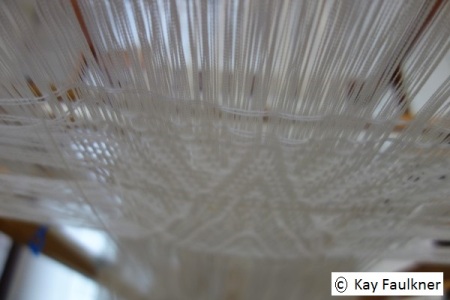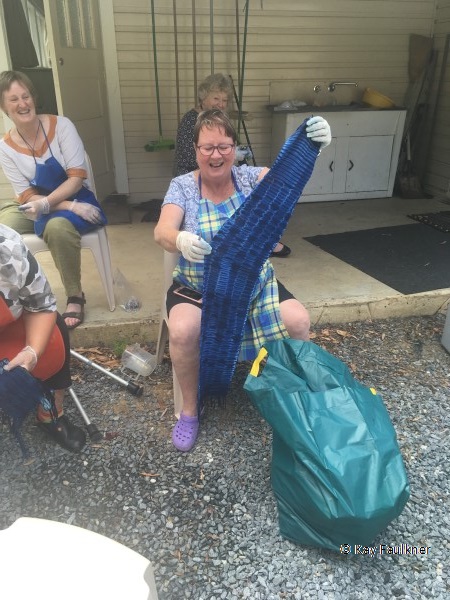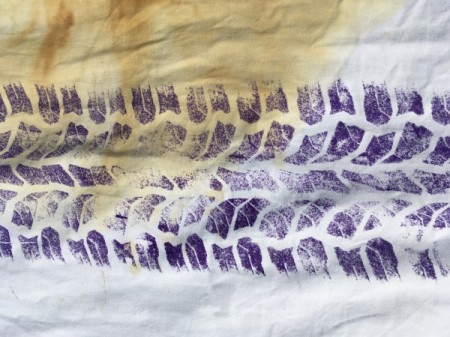All is organised for the exhibition next month. Here’s the invitation. Next month of course there’ll be more on the exhibition. It will be well under way by then.
RAG Invites March 2019 Parallel HR
Now to continue on from last month’s blog. I had started to explore the possibility of weaving with a vertical storage positioned between the beater and the shafts. Previously I had worked with it behind the heddles at the back of the loom. Having it positioned at the rear of the loom allows for free movement of the shafts. Having the storage in front of the loom means that if anything is selected on the pattern shafts, it has to either work with the heddles or it has to be disengaged every time the basic fabric structure is woven.
In the previous month, I explored the use of the stored pattern being used in addition to plain weave to create vertical floats for Bronson Lace. This is an ideal application. What else could I do? As an extra challenge, all the patterns to be woven had to have elements of the same pattern developed for the Bronson Lace.
I have already shown this image of 3 approaches last month. The previous month recorded the process of weaving Bronson Lace. As you’ll see there was more woven on this warp.

It is extremely logical to achieve weft floats for woven shibori. It was also timely weaving some woven shibori as it has been the focus over my studio work leading up to next month’s exhibition. The resist floats can easily be stored in the vertical storage. It is common and especially so in this pattern, that every resist row is different. This suits storing it and allows for a progression of sequences with plain weave being woven on the shafts between.
This undyed woven shibori design shows direct correlation to the Bronson Lace table mat.

I decided to explore other possibilities.
The next challenge was to weave the design as a supplementary weft motif. This is a typical style of weaving for this type of loom in S E Asia. I have modified and extended the original pattern. There are 37 pattern rows. As this is an image with a mirror repeat, I needed to store the design to achieve this. I have discovered that the number of bamboo sticks that can be efficiently used to store a design is limited. This was my opportunity to investigate using loops of thread to store the design. I was very familiar with this from Se Asia but had never had the occasion to apply it.
Loops of thread are passed between the long heddles instead of bamboo or dowel. These loops are suspended on hooks attached to a length of wood. For multiple repeats, there need to be a series of hooks at the top and bottom of the storage unit.

See blog October 2015 (second half of the blog) for a full explanation on how to pick up the motif and store a design.

Here’s a close up of the storage loops. Move each one down (or up) to select the next pattern row.

Looking from the top down, the stored pattern can be easily seen.

Two rows of pattern are woven, separated by a row of plain weave. As I suspected, I needed to deselect the pattern lift between plain weave rows. The lift otherwise would be included in the plain weave. Having the storage unit behind the shafts means that the selection does not alter plain weave. The same pattern row can be left selected for however long you wished to weave the same row. In this case however no selection could be maintained. Rather I left the thread loop in position and reloaded the pattern lift for the repeated row. It was a little inconvenient however the ease of storing the pattern made up for this inconvenience. In spite of the double handling of the pattern loop, weaving the reverse of the pattern happened surprisingly quickly. I took nearly 2 days to pick up the pattern and wove it backwards in less than 3 hours with a cuppa included.

Rather than weaving a long runner with several reversals of the stored pattern, I wondered what else was possible.
I decided to revisit Becker’s Pattern and Loom and repeat the technique I had already explored. (Blog: September 2017 ) I decided to start with a simplified smaller version of the same motif that I’d been using. Rather than paired threads there were 4 or 6 threads lifted together. The design is interpreted so that each square equals 2 threads, necessary for this technique of changing twill direction to work, so 3 squares in this case equals 6 ends. The front and back of this series are labelled below.
I soon decided that I didn’t like the effect. (A)
Next I reworked the design so that there were only single squares to be lifted. This was then woven in the style outlined in Becker. There is that interesting effect of the sides of the diamond being different. (B)
It was in my mind that the weavers of Cambodia ( Blog: May 2017) wove diagonal lines using this loom set up and basic principle. I have this lovely ikat cushion with the diamond ground structure. It is woven in plain weave with pattern shafts.

I decided that structurally this would be achieved by including either an extra thread being picked up at the reversal points in the stored design or an extra row being woven in the weaving sequence. This would achieve the outside threads in a series of 3 working in the same manner. I now have a clean diagonal line. (C) The same motif is used for B and C.
The final motif in this series works with a stored lift of 2 or 3 pairs lifted together in combination with a single pair. In essence it is an extension of A and C. One extra thread or row is included at the reversal points. Again the lines are clean. (D)
It is important to note that the reversal points in C and D must be on the same line of the treadling sequence.
Here is the record of that series. A is on the right.

And then I ran out of warp! This is an overview of all the work from that warp.

The really great news is that all that effort I took in preparing the warp so that individual warp threads pass through single long heddles is done, ready for the next experiment.

The Handweavers Guild of Tasmania had invited me to run two, two day woven shibori workshops. One was in Launceston. The other was in Hobart.
Both groups produced an exciting array of work. It is quite amazing what was achieved in two days. Weavers wove on rigid heddle looms as well as those with 4 or 8 shafts.
Here are some images.
The Northern Group.



The Southern Group.



Thanks go to the organisers of both workshops and to the weavers who participated so enthusiastically and with such a willingness to learn.
Coming up next month:
The report on the exhibition.
The studio class on Woven Shibori will be from 18-22 March. There are still places available. Right now I’m working at setting up warps for this class. If you would like to attend and work on a specific project, this is also an available option. There are a number of design approaches being set up but as usual there is often something out of left field.
This loom has been set up to weave an 8 shaft fabric on an 8 shaft loom with a 5 shaft warp shibori pattern using a horizontal storage system. This system is typical of SE Asia. It is a very useful technique for any situation where you need just one or more shafts extra to what you’ve got available.

For full details of this class: woven shibori
The featured image at the top of this blog is an image of the hard copy invitation.



 Posted by kayfaulkner
Posted by kayfaulkner 









 An exhibition celebrating 20 years of woven shibori with Catharine Ellis. 10th March- 14 April 2019, Redland Art Gallery.
An exhibition celebrating 20 years of woven shibori with Catharine Ellis. 10th March- 14 April 2019, Redland Art Gallery.

















































































































 “Pattern and Loom” by John Becker,
“Pattern and Loom” by John Becker,


 The book also shows a horizontal storage system being used. However, I also knew that I could store it on the vertical storage system. Initially this is what I used.
The book also shows a horizontal storage system being used. However, I also knew that I could store it on the vertical storage system. Initially this is what I used.



































































